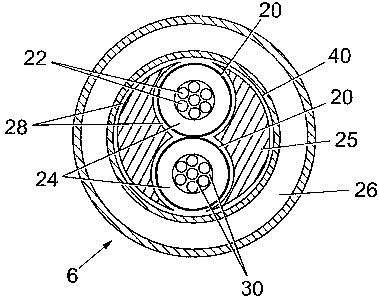Some of the information on this Web page has been provided by external sources. The Government of Canada is not responsible for the accuracy, reliability or currency of the information supplied by external sources. Users wishing to rely upon this information should consult directly with the source of the information. Content provided by external sources is not subject to official languages, privacy and accessibility requirements.
Any discrepancies in the text and image of the Claims and Abstract are due to differing posting times. Text of the Claims and Abstract are posted:
| (12) Patent: | (11) CA 2662455 |
|---|---|
| (54) English Title: | SUBSEA UMBILICAL |
| (54) French Title: | OMBILICAL SOUS-MARIN |
| Status: | Granted and Issued |
| (51) International Patent Classification (IPC): |
|
|---|---|
| (72) Inventors : |
|
| (73) Owners : |
|
| (71) Applicants : |
|
| (74) Agent: | NORTON ROSE FULBRIGHT CANADA LLP/S.E.N.C.R.L., S.R.L. |
| (74) Associate agent: | |
| (45) Issued: | 2015-07-21 |
| (86) PCT Filing Date: | 2007-09-04 |
| (87) Open to Public Inspection: | 2008-03-20 |
| Examination requested: | 2012-08-14 |
| Availability of licence: | N/A |
| Dedicated to the Public: | N/A |
| (25) Language of filing: | English |
| Patent Cooperation Treaty (PCT): | Yes |
|---|---|
| (86) PCT Filing Number: | PCT/GB2007/003307 |
| (87) International Publication Number: | WO 2008032019 |
| (85) National Entry: | 2009-03-02 |
| (30) Application Priority Data: | |||||||||
|---|---|---|---|---|---|---|---|---|---|
|
An umbilical for use in the offshore production of hydrocarbons, the umbilical comprising a plurality of functional elements contained within an outer sheath, at least one of said functional elements comprising a multicore electric cable, said multicore electric cable comprising a plurality of insulated electric conductors electrically insulated from each other and assembled together in a helical or S/Z manner, said multicore electric cable further comprising a protective polymer sheath surrounding said plurality of insulated electric conductors, said multicore electric cable further comprising a tubular metallic layer located inside said protective polymer sheath and surrounding said plurality of insulated electric conductors.
La présente invention concerne un ombilical conçu pour être utilisé dans la production offshore d'hydrocarbures. Cet ombilical comprend plusieurs éléments fonctionnels contenus dans une gaine externe, au moins un de ces éléments fonctionnels comprenant un câble électrique multiconducteur qui comporte plusieurs conducteurs électriques isolés, lesquels conducteurs sont isolés les uns des autres et sont assemblés selon une configuration hélicoïdale ou S/Z, ainsi qu'une gaine protectrice en polymère qui entoure lesdits conducteurs électriques isolés et une couche métallique tubulaire qui se trouve à l'intérieur de la gaine protectrice en polymère et qui entoure lesdits conducteurs électriques isolés.
Note: Claims are shown in the official language in which they were submitted.
Note: Descriptions are shown in the official language in which they were submitted.

2024-08-01:As part of the Next Generation Patents (NGP) transition, the Canadian Patents Database (CPD) now contains a more detailed Event History, which replicates the Event Log of our new back-office solution.
Please note that "Inactive:" events refers to events no longer in use in our new back-office solution.
For a clearer understanding of the status of the application/patent presented on this page, the site Disclaimer , as well as the definitions for Patent , Event History , Maintenance Fee and Payment History should be consulted.
| Description | Date |
|---|---|
| Maintenance Fee Payment Determined Compliant | 2024-08-26 |
| Maintenance Request Received | 2024-08-26 |
| Common Representative Appointed | 2019-10-30 |
| Common Representative Appointed | 2019-10-30 |
| Grant by Issuance | 2015-07-21 |
| Inactive: Cover page published | 2015-07-20 |
| Inactive: Final fee received | 2015-04-28 |
| Pre-grant | 2015-04-28 |
| Notice of Allowance is Issued | 2014-10-29 |
| Notice of Allowance is Issued | 2014-10-29 |
| Letter Sent | 2014-10-29 |
| Inactive: Approved for allowance (AFA) | 2014-10-21 |
| Inactive: Q2 passed | 2014-10-21 |
| Letter Sent | 2014-10-03 |
| Amendment Received - Voluntary Amendment | 2014-10-02 |
| Maintenance Request Received | 2014-09-23 |
| Reinstatement Request Received | 2014-09-23 |
| Reinstatement Requirements Deemed Compliant for All Abandonment Reasons | 2014-09-23 |
| Deemed Abandoned - Failure to Respond to Maintenance Fee Notice | 2014-09-04 |
| Inactive: S.30(2) Rules - Examiner requisition | 2014-04-07 |
| Inactive: Report - No QC | 2014-03-26 |
| Inactive: Office letter | 2013-09-30 |
| Inactive: Correspondence - Prosecution | 2013-08-08 |
| Letter Sent | 2012-09-04 |
| Request for Examination Received | 2012-08-14 |
| All Requirements for Examination Determined Compliant | 2012-08-14 |
| Request for Examination Requirements Determined Compliant | 2012-08-14 |
| Inactive: Cover page published | 2009-07-03 |
| Inactive: Notice - National entry - No RFE | 2009-06-08 |
| Inactive: First IPC assigned | 2009-05-09 |
| Application Received - PCT | 2009-05-08 |
| National Entry Requirements Determined Compliant | 2009-03-02 |
| Application Published (Open to Public Inspection) | 2008-03-20 |
| Abandonment Date | Reason | Reinstatement Date |
|---|---|---|
| 2014-09-23 | ||
| 2014-09-04 |
The last payment was received on 2014-09-23
Note : If the full payment has not been received on or before the date indicated, a further fee may be required which may be one of the following
Please refer to the CIPO Patent Fees web page to see all current fee amounts.
Note: Records showing the ownership history in alphabetical order.
| Current Owners on Record |
|---|
| TECHNIP FRANCE SA |
| Past Owners on Record |
|---|
| ALAN DEIGHTON |
| JOE SIU KIT WONG |